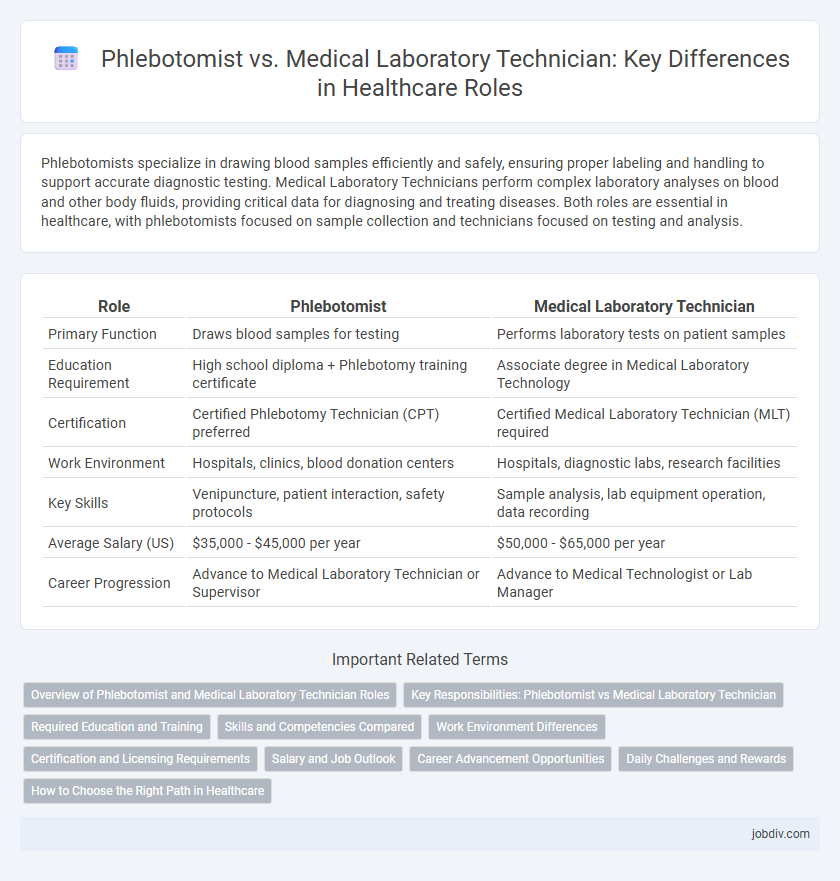Phlebotomists specialize in drawing blood samples efficiently and safely, ensuring proper labeling and handling to support accurate diagnostic testing. Medical Laboratory Technicians perform complex laboratory analyses on blood and other body fluids, providing critical data for diagnosing and treating diseases. Both roles are essential in healthcare, with phlebotomists focused on sample collection and technicians focused on testing and analysis.
Table of Comparison
| Role | Phlebotomist | Medical Laboratory Technician |
|---|---|---|
| Primary Function | Draws blood samples for testing | Performs laboratory tests on patient samples |
| Education Requirement | High school diploma + Phlebotomy training certificate | Associate degree in Medical Laboratory Technology |
| Certification | Certified Phlebotomy Technician (CPT) preferred | Certified Medical Laboratory Technician (MLT) required |
| Work Environment | Hospitals, clinics, blood donation centers | Hospitals, diagnostic labs, research facilities |
| Key Skills | Venipuncture, patient interaction, safety protocols | Sample analysis, lab equipment operation, data recording |
| Average Salary (US) | $35,000 - $45,000 per year | $50,000 - $65,000 per year |
| Career Progression | Advance to Medical Laboratory Technician or Supervisor | Advance to Medical Technologist or Lab Manager |
Overview of Phlebotomist and Medical Laboratory Technician Roles
Phlebotomists specialize in drawing blood samples from patients for testing, transfusions, or donations, ensuring proper labeling and patient identification. Medical Laboratory Technicians perform complex laboratory tests on blood, tissues, and other bodily fluids to assist in diagnosing diseases and monitoring patient health. Both roles require strong attention to detail, but Medical Laboratory Technicians typically have more extensive training and handle a broader range of diagnostic procedures.
Key Responsibilities: Phlebotomist vs Medical Laboratory Technician
Phlebotomists specialize in drawing blood from patients for diagnostic testing, blood donations, or transfusions, ensuring proper sample collection and handling. Medical Laboratory Technicians perform detailed analysis of blood, tissue, and other bodily fluids using sophisticated laboratory equipment to detect diseases and monitor health conditions. Both roles require adherence to strict safety protocols and accurate record-keeping, but Medical Laboratory Technicians engage more extensively in specimen testing and result interpretation.
Required Education and Training
Phlebotomists typically require a high school diploma followed by a phlebotomy training program, which can take a few weeks to several months, along with certification through organizations like the National Phlebotomy Association. Medical Laboratory Technicians (MLTs) generally need an associate degree in clinical laboratory science or medical laboratory technology, which takes about two years, plus certification from bodies such as the American Society for Clinical Pathology. Both roles require hands-on clinical training, but MLTs undergo more extensive education to perform complex lab testing beyond blood collection.
Skills and Competencies Compared
Phlebotomists specialize in venipuncture and specimen collection, demonstrating proficiency in patient interaction, aseptic techniques, and precise sample labeling to ensure accurate laboratory results. Medical Laboratory Technicians possess advanced skills in analyzing blood, bodily fluids, and tissue samples using sophisticated laboratory equipment, with competencies in operating diagnostic instruments and interpreting complex data for disease detection. Both roles require attention to detail and adherence to safety protocols, but Medical Laboratory Technicians demand a deeper understanding of clinical laboratory testing and quality control processes.
Work Environment Differences
Phlebotomists primarily work in blood donation centers, hospitals, and outpatient clinics where their main responsibility is drawing blood for tests, transfusions, or donations. Medical Laboratory Technicians operate in hospital labs, diagnostic laboratories, and research facilities, focusing on analyzing blood, tissue, and other bodily fluids using complex machinery. The work environment for phlebotomists tends to be fast-paced with frequent patient interaction, whereas medical laboratory technicians often work behind the scenes in controlled lab settings.
Certification and Licensing Requirements
Phlebotomists typically require a certification from recognized organizations such as the American Society for Clinical Pathology (ASCP) or the National Phlebotomy Association (NPA), with some states mandating licensure for practice. Medical Laboratory Technicians (MLTs) must obtain certification through entities like the American Medical Technologists (AMT) or ASCP, and licensure requirements vary by state, often involving passing a national examination and completing accredited education. Both professions emphasize standardized certification to ensure competence in specimen collection, laboratory testing, and patient safety protocols.
Salary and Job Outlook
Phlebotomists earn a median annual salary of approximately $37,000, while Medical Laboratory Technicians have a higher median salary near $55,000. The job outlook for phlebotomists is projected to grow by 17% from 2022 to 2032, reflecting increased demand for blood collection services. In comparison, employment for medical laboratory technicians is expected to grow by about 7%, driven by advances in laboratory technology and expanding healthcare needs.
Career Advancement Opportunities
Phlebotomists gain foundational experience in blood collection and patient interaction, which can lead to advanced certifications or transitions into roles such as Medical Laboratory Technicians (MLTs). Medical Laboratory Technicians have broader responsibilities, including performing complex tests and analyzing results, providing greater opportunities for specialization and supervisory positions. Career advancement for MLTs often includes roles like laboratory supervisors, technologists, or moving into healthcare management and research fields.
Daily Challenges and Rewards
Phlebotomists face daily challenges like managing patient anxiety and ensuring accurate blood draws, which require precision and strong interpersonal skills. Medical Laboratory Technicians encounter complex diagnostic testing tasks, demanding high attention to detail and proficiency with advanced laboratory equipment. Both roles offer the reward of directly contributing to patient health outcomes and supporting critical medical decisions.
How to Choose the Right Path in Healthcare
Choosing between a phlebotomist and a medical laboratory technician depends on your interest in patient interaction versus laboratory analysis. Phlebotomists specialize in drawing blood and ensuring patient comfort, while medical laboratory technicians perform complex tests that assist in diagnosing diseases. Evaluate your skills, education goals, and preferred work environment to determine the best healthcare career path that matches your strengths and aspirations.
Phlebotomist vs Medical Laboratory Technician Infographic

 jobdiv.com
jobdiv.com